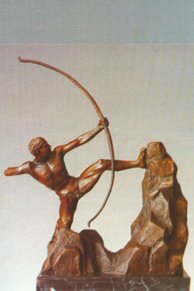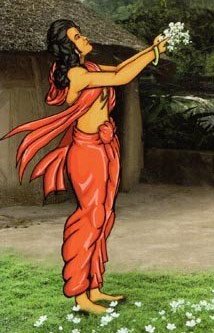Kuthara, Kuṭhāra, Kuṭhara: 23 definitions
Introduction:
Kuthara means something in Hinduism, Sanskrit, Jainism, Prakrit, Marathi, Hindi. If you want to know the exact meaning, history, etymology or English translation of this term then check out the descriptions on this page. Add your comment or reference to a book if you want to contribute to this summary article.
Alternative spellings of this word include Kuthar.
In Hinduism
Dhanurveda (science of warfare)
Source: Wisdom Library: DhanurvedaKuṭhāra (कुठार) refers to a weapon (“axe”). It is a Sanskrit word defined in the Dhanurveda-saṃhitā, which contains a list of no less than 117 weapons. The Dhanurveda-saṃhitā is said to have been composed by the sage Vasiṣṭha, who in turn transmitted it trough a tradition of sages, which can eventually be traced to Śiva and Brahmā.

Dhanurveda (धनुर्वेद) refers to the “knowledge of warfare” and, as an upaveda, is associated with the Ṛgveda. It contains instructions on warfare, archery and ancient Indian martial arts, dating back to the 2nd-3rd millennium BCE.
Purana and Itihasa (epic history)
Source: archive.org: Puranic Encyclopedia1) Kuṭhara (कुठर).—A prominent nāga. He was present among the nāgas, who went to receive Balabhadra when he went, in the form of nāga, into the sea. (Mausala Parva, Chapter 4, Verse 15).
2) Kuṭhāra (कुठार).—A nāga born in Dhṛtarāṣṭra’s family. It was burned to death at the serpent yajña of Janamejaya. (Ādi Parva, Chapter 57, Verse 15).
Source: archive.org: Shiva Purana - English TranslationKuṭhāra (कुठार) refers to “(one who acts as the) axe”, according to the Śivapurāṇa 2.5.2 (“The Prayer of the gods).—Accordingly, as the Gods eulogized Śiva: “[...] Obeisance to Thee, the lord of all beings, the sustainer of great burden, the remover of thirst, to Thee whose form is devoid of enmity, to Thee of excessive splendour. Obeisance to Thee, the destroyer of the great forest in the form of great Asuras, like conflagration. Obeisance to the Trident-bearing lord who acts as the axe (kuṭhāra) for the trees of Asuras. [...]”.
Source: JatLand: List of Mahabharata people and placesKuṭhāra (कुठार) is a name mentioned in the Mahābhārata (cf. I.52.14, I.57) and represents one of the many proper names used for people and places. Note: The Mahābhārata (mentioning Kuṭhāra) is a Sanskrit epic poem consisting of 100,000 ślokas (metrical verses) and is over 2000 years old.
Source: Wisdomlib Libary: The Brahmāṇḍa-purāṇaKuṭhāra (कुठार) refers to “daggers” and represents one of the various weapons equipped by the Daityas in their war against Lalitā, according to the Brahmāṇḍa-purāṇa 4.22. Accordingly, “[...] thereupon, crores of Daityas producing reverberating chattering noise furiously prepared themselves (to fight) against Parameśvarī (Lalitā). [...] Crores of Daityas were fully equipped with coats of mail and had the following weapons and missiles in their hands [viz.: Kuṭhāras (daggers)], and thousands of similar weapons and missiles very dreadful and capable of destroying living beings”.
Source: Shodhganga: Kasyapa Samhita—Text on Visha Chikitsa (itihasa)Kuṭhara is the name of a Serpent (sarpa) mentioned in the thirty-fifth chapter (verses 4-17) of the Ādiparva of the Mahābhārata.—Accordingly, Sauti, on being implored by Śaunaka to name all the serpents in the course of the sarpa-sattra, tells him that it is humanly impossible to give a complete list because of their sheer multiplicity; but would name the prominent ones in accordance with their significance [e.g., Kuṭhara].

The Purana (पुराण, purāṇas) refers to Sanskrit literature preserving ancient India’s vast cultural history, including historical legends, religious ceremonies, various arts and sciences. The eighteen mahapuranas total over 400,000 shlokas (metrical couplets) and date to at least several centuries BCE.
Kavya (poetry)
Source: OpenEdition books: Vividhatīrthakalpaḥ (Kāvya)Kuṭhāra (कुठार) in Sanskrit (or Kuhāḍa in Prakrit) refers to an “ax”, as is mentioned in the Vividhatīrthakalpa by Jinaprabhasūri (13th century A.D.): an ancient text devoted to various Jaina holy places (tīrthas).—(CDIAL 3244; Williams 1959 p. 360).

Kavya (काव्य, kavya) refers to Sanskrit poetry, a popular ancient Indian tradition of literature. There have been many Sanskrit poets over the ages, hailing from ancient India and beyond. This topic includes mahakavya, or ‘epic poetry’ and natya, or ‘dramatic poetry’.
Shaivism (Shaiva philosophy)
Source: Brill: Śaivism and the Tantric TraditionsKuṭhāra (कुठार) refers to the “axe (of indifference)” (cutting the great tree of transmigration), according to the Vārāṇasīmāhātmya verse 1.114.—Accordingly, “The great tree of transmigration has arisen from the seed of desire. After cutting the tree with the axe of indifference (kuṭhāra), whose sharp blade is disattachment, they proceed on the Atimārga”.

Shaiva (शैव, śaiva) or Shaivism (śaivism) represents a tradition of Hinduism worshiping Shiva as the supreme being. Closely related to Shaktism, Shaiva literature includes a range of scriptures, including Tantras, while the root of this tradition may be traced back to the ancient Vedas.
General definition (in Hinduism)
Source: Wisdom Library: HinduismKuṭhāra (कुठार)—Sanskrit word for a type of Battle-ax mentioned in the Mahābhārata.
In Jainism
General definition (in Jainism)
Source: The University of Sydney: A study of the Twelve ReflectionsKuṭhāra (कुठार) refers to “axes”, according to the 11th century Jñānārṇava, a treatise on Jain Yoga in roughly 2200 Sanskrit verses composed by Śubhacandra.—Accordingly, “Here in the cycle of rebirth consisting of endless misfortune, sentient beings roam about repeatedly, struck down by spear, axe (kuṭhāra), vice, fire, corrosive liquid or razor in hell, consumed by the multitude of flames from the fire of violent actions in the plant and animal world , and subject to unequalled trouble in the human condition [or] full of desire among the gods. [Thus ends the reflection on] the cycle of rebirth.”.

Jainism is an Indian religion of Dharma whose doctrine revolves around harmlessness (ahimsa) towards every living being. The two major branches (Digambara and Svetambara) of Jainism stimulate self-control (or, shramana, ‘self-reliance’) and spiritual development through a path of peace for the soul to progess to the ultimate goal.
Languages of India and abroad
Marathi-English dictionary
Source: DDSA: The Molesworth Marathi and English Dictionarykuṭhāra (कुठार).—m S An ax or a hatchet.
Source: DDSA: The Aryabhusan school dictionary, Marathi-Englishkuṭhāra (कुठार).—m An axe or a hatchet.
Marathi is an Indo-European language having over 70 million native speakers people in (predominantly) Maharashtra India. Marathi, like many other Indo-Aryan languages, evolved from early forms of Prakrit, which itself is a subset of Sanskrit, one of the most ancient languages of the world.
Sanskrit dictionary
Source: DDSA: The practical Sanskrit-English dictionaryKuṭhara (कुठर).—See कुटर (kuṭara).
--- OR ---
Kuṭhāra (कुठार).—
1) An axe, or hatchet; मातुः केवलमेव यौवनवनच्छेदे कुठारा वयम् (mātuḥ kevalameva yauvanavanacchede kuṭhārā vayam) Bhartṛhari 3.11.
2) A sort of hoe or spade; Kau. A.2.3.
-raḥ A tree.
Derivable forms: kuṭhāraḥ (कुठारः).
See also (synonyms): kuṭhārī.
Source: Cologne Digital Sanskrit Dictionaries: Shabda-Sagara Sanskrit-English DictionaryKuṭhara (कुठर).—m.
(-raḥ) The post round which the string of the churning stick winds: see kuṭara. E. kuṭh to surround, karan aff.
--- OR ---
Kuṭhāra (कुठार).—mf. (-raḥ-rī) 1. An axe. 2. A sort of hoe or spade. m.
(-raḥ) A tree. E. kuṭha a tree, and ṛ to go, affix aṇ.
Source: Cologne Digital Sanskrit Dictionaries: Benfey Sanskrit-English DictionaryKuṭhāra (कुठार).—m. (and f. rī), I. An axe, [Rāmāyaṇa] 2, 35, 41. Ii. m. The name of a Nāga or serpent, Mahābhārata 1, 2156.
Source: Cologne Digital Sanskrit Dictionaries: Cappeller Sanskrit-English DictionaryKuṭhāra (कुठार).—[masculine] axe; rikā [feminine] a small axe.
Source: Cologne Digital Sanskrit Dictionaries: Monier-Williams Sanskrit-English Dictionary1) Kuṭhara (कुठर):—m. the post round which the string of the churning-stick winds, [cf. Lexicographers, esp. such as amarasiṃha, halāyudha, hemacandra, etc.]
2) m. Name of a Nāga, [Mahābhārata i, 1560] ([varia lectio] kuṭara).
3) Kuṭhāra (कुठार):—[from kuṭhā-ṭaṅka] m. an axe, [Rāmāyaṇa; Bhartṛhari] etc.
4) [v.s. ...] a sort of hoe or spade, [Horace H. Wilson]
5) [v.s. ...] a tree (= kuṭha), [cf. Lexicographers, esp. such as amarasiṃha, halāyudha, hemacandra, etc.]
6) [v.s. ...] Name of a man [gana] śivādi
7) [v.s. ...] of a Nāga, [Mahābhārata i, 2156]
Source: Cologne Digital Sanskrit Dictionaries: Yates Sanskrit-English Dictionary1) Kuṭhara (कुठर):—(raḥ) 1. m. The post round which the string of the churning stick winds.
2) Kuṭhāra (कुठार):—[(raḥ-rī)] 1. m. 3. f. Sort of hoe or spade. m. A tree.
Source: DDSA: Paia-sadda-mahannavo; a comprehensive Prakrit Hindi dictionary (S)Kuṭhāra (कुठार) in the Sanskrit language is related to the Prakrit words: Kuḍhāra, Kuhāḍa.
[Sanskrit to German]
Sanskrit, also spelled संस्कृतम् (saṃskṛtam), is an ancient language of India commonly seen as the grandmother of the Indo-European language family (even English!). Closely allied with Prakrit and Pali, Sanskrit is more exhaustive in both grammar and terms and has the most extensive collection of literature in the world, greatly surpassing its sister-languages Greek and Latin.
Hindi dictionary
Source: DDSA: A practical Hindi-English dictionaryKuṭhāra (कुठार) [Also spelled kuthar]:—(nm) a kind of axe or hatchet; ~[rāghāta] a violent stroke.
...
Kannada-English dictionary
Source: Alar: Kannada-English corpusKuṭhara (ಕುಠರ):—[noun] a post to which the churning stick is tied while churning.
--- OR ---
Kuṭhāra (ಕುಠಾರ):—
1) [noun] a chopping tool, usu. of iron with a steel edge and wooden handle; an axe.
2) [noun] a long metal bar with a sharp end, used to dig the earth or as a lever; a crowbar.
3) [noun] an iron bar used as a weapon (in a medieval war).
4) [noun] (fig.) one who destroys; a destroyer.
Kannada is a Dravidian language (as opposed to the Indo-European language family) mainly spoken in the southwestern region of India.
See also (Relevant definitions)
Starts with: Kutarai, Kutharadhara, Kutharaka, Kutharapraya, Kutharasabha, Kuttaracam.
Ends with: Agnikuthara, Arikuthara, Arshahkuthara, Cancatkuthara, Dattakakuthara, Gamvakuthara, Ghayakuthara, Gotrakuthara, Kasakuthara, Kayasthakshatriyatvadrumadalanakuthara, Khandanakuthara, Kulakuthara, Kuradikuthara, Kurudikuthara, Mahashvasakuthara, Mulakuthara, Nattakkuttara, Samnipatakuthara, Shulakuthara, Shvasakuthara.
Full-text (+17): Kutara, Kauthara, Kuthari, Kutharaka, Shvasakuthara, Kuhada, Kutaka, Kuthatanka, Gramakantaka, Kudhara, Mangalakutharamishra, Ghayakuthara, Kotari, Kuthar, Kuttara, Kunmakkutori, Amsakuta, Kotali, Pattisha, Kutharika.
Relevant text
Search found 22 books and stories containing Kuthara, Kuṭhāra, Kuṭhara; (plurals include: Kutharas, Kuṭhāras, Kuṭharas). You can also click to the full overview containing English textual excerpts. Below are direct links for the most relevant articles:
Rasa Jala Nidhi, vol 4: Iatrochemistry (by Bhudeb Mookerjee)
Treatment for fever (72): Sannipata-kuthara rasa < [Chapter II - Fever (jvara)]
Part 2 - Treatment of Piles (1): Arsha-kuthara rasa < [Chapter V - Piles]
Part 17 - Treatment of Piles (16): Chanchat-kuthara rasa < [Chapter V - Piles]
Hanuman Nataka (critical study) (by Nurima Yeasmin)
9.6. The character of Paraśurāma < [Chapter 4]
Nitiprakasika (Critical Analysis) (by S. Anusha)
Khaḍga (Sword) < [Chapter 3]
Mahabharata (English) (by Kisari Mohan Ganguli)
Harshacharita (socio-cultural Study) (by Mrs. Nandita Sarmah)
18. Description of Machines and Tools < [Chapter 6 - Other Socio-Cultural Aspects]
1. Similarities (5): Economic Condition < [Chapter 8 - Comparative Society as described in the Kādambarī and the Harṣacarita]
4. Economic Condition < [Chapter 6 - Other Socio-Cultural Aspects]
Puranic encyclopaedia (by Vettam Mani)